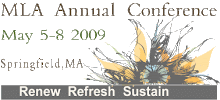Clickers:
http://www.vanderbilt.edu/cft
http://www.educause.edu/ir
http://www.qwizdom.com/ (The Q4 specifically)
Coverage of the annual conference of the Massachusetts Library Association
http://www.vanderbilt.edu/cft
http://www.educause.edu/ir
http://www.qwizdom.com/ (The Q4 specifically)
DEFINING NEGOTIATION
Interesting statement from Sullivan: "It's only been in the last five years that I have started to see staffs in libraries as a team, really focused on service to the constituency."
This observation seemed extremely important. Seems that libraries need to work as teams more than they did in the past, since it is less likely to have departments doing individual tasks.
Sullivan recommended that "Behavior that happens outside of the group is harmful to the team and should be addressed. Outside conversation against the team is behavior that is harmful to the group. "
Sometimes we just "accept that we disagree" but sometimes we need to understandthe underlying causes of disagreement.
Conflict and How to Deal Constructively with it:
Steps to Constructive Resolution of Conflict:
1. Focus on the issue, not the personalities.
2. Avoid blaming and pointing fingers.
3. Manage your emotions.
4. Use empathy to understand the other party's position.
5. Take the time required to work through the issue.
Thoughts from Sullivan: "We need more play in our libraries."
"Pose the question in your library: What are we here together to do?"
"In a team, the synergy, becomes a way of working together."
"Collaborative comes out of the meaning of co-labor, working together."
"Where am I spending my time, where are you putting your effort?"
"We have a basic need to connect to other humans."
The group took some time to consider what they want to negotiate in the future.
Final thoughts:
There needs to be a place to communicate.
"Email can ruin your day." It is important to use it as a tool for facts and try to avoid emotion.
Face to face conversation is important.
If we do use email. Stop, read, and edit.
Ex: "Reference upstairs and Children's Room upstairs sharing the computer facilities is an important issue." This is a situation with which many can identify and perhaps negotiate.
This was a very valuable session and an important skill for library leaders, but the also provided a good list of suggestions for librarians, useful in many situations.

 The session began by satisfying what I guess has been a longtime dream of Gene's, to hit a beach ball around a conference center ballroom. After a bit, a couple of hits in the face and a brief conversation with Bill, they began their session.
The session began by satisfying what I guess has been a longtime dream of Gene's, to hit a beach ball around a conference center ballroom. After a bit, a couple of hits in the face and a brief conversation with Bill, they began their session. Dewey, the young, male teen-services library (on whom I have a rather significant crush), the rest of the Mallville Library staff and of course, the crazy patrons. Check out the Primer on the website to find out who's who.
Dewey, the young, male teen-services library (on whom I have a rather significant crush), the rest of the Mallville Library staff and of course, the crazy patrons. Check out the Primer on the website to find out who's who.
 Margaret Cardello of the Central Massachusetts Regional Library System and a cooperative effort of most of the Massachusetts Library regions were awarded an LSTA grant to develop a Director's Essentials website. An advisory committee has been meeting for the last six months and the project is lifting off the ground with a Director's Boot Camp at Tower Hill in West Boylston on May 20th. Currently, the advisory group is gathering the information that will make a new Massachusetts director's job easier.
Margaret Cardello of the Central Massachusetts Regional Library System and a cooperative effort of most of the Massachusetts Library regions were awarded an LSTA grant to develop a Director's Essentials website. An advisory committee has been meeting for the last six months and the project is lifting off the ground with a Director's Boot Camp at Tower Hill in West Boylston on May 20th. Currently, the advisory group is gathering the information that will make a new Massachusetts director's job easier.Katie pushed the group to not think sequentially as left-brainers. If we're going to survive as part of the movement out of information age into the realm of creativity - how can we get beyond describing ourselves in ordered, sequential terms? More responses:
One of the six senses Pink defines as integral to the Conceptual Age is Empathy. (Others are Design, Story, Symphony, Play and Meaning.)
Are we perceived by our users as empathetic? How about the librarian action figure? Why did we embrace it? Because of the irony of it or because it's true?
Is empathy different from warm and fuzzy?
Where are we as supporters of the quest? How are we going to redesign our spaces to articulate what we really do?
 Speakers: Bill Barnes and Gene Ambaum
Speakers: Bill Barnes and Gene Ambaum
Dr. Lesley Farmer, California State University
Teens' Information-Seeking Behavior
Choosing Web Sites According to Teens
YA Internet Truisms
What is Reference Service to a Teen?
What Teens Want
Co-constructing with Teen Brains
Using the Whole New Mind
Start Where Teens Are
Practice Reflective Learning: I-Search Projects
Final Thoughts
Posted by Kathy Lowe
 Presenter: Dr. Leslie Farmer, Cal State, Long Beach
Presenter: Dr. Leslie Farmer, Cal State, Long Beach Impact of the teenage brain:
Impact of the teenage brain: Who's rethinking resource sharing?
Who's rethinking resource sharing?